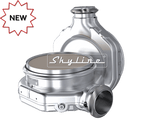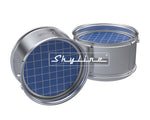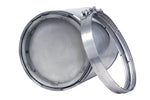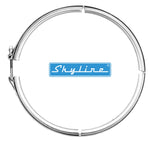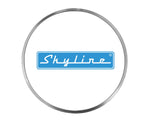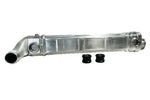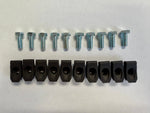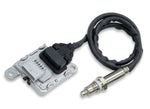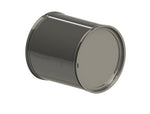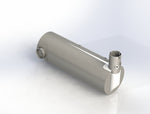Your cart is empty
Looks like you haven't added anything to your cart yet

The Coming Convergence of Starter and APU Batteries in Long-Haul Trucking
”We’ve used diesel APUs, but the maintenance costs were too high,”
said Mark Stahl, maintenance director at Central Trucking. “We also
tried a different brand of electric APU, but the batteries didn’t last long
enough to keep the air conditioning going for the full 10 hours. When
that happens, the drivers understandably get upset.”
– Mark Stahl, Maintenance Director at Central Trucking
Intro
For as long as heavy-duty trucks have been crisscrossing the continental U.S., one critical piece of powertrain technology has stayed basically the same: the tried-and-true lead-acid starter battery remains the dominate way truckers start their engines. Over the more recent past twenty years, as air quality regulations intensified in California and other states, another part of the truck has seen rapid adoption and innovation: the Auxiliary Power Unit (APU) to run cabin heating, cooling, and power loads while the truck is parked and engine is off.
Up until just recently, these two applications have been served by two separate pieces of equipment on the truck. With recent advances in Lithium-ion battery technology, which is now pervading nearly all parts of the automotive market, combining these two applications into one clever package is finally becoming cost competitive.
In the following whitepaper, we’ll explore the technologies that are making this convergence possible, the cost implications for fleet managers, and the companies that are leading this technology transition.
Starter Battery Status Quo
Most long-haul Class 8 trucks use four Group 31 flooded or sealed lead acid batteries wired together in series for 12V, 1000 Cold Cranking Amp (CCA) performance. Due to their mission critical nature, starter batteries need to perform in both extreme cold and heat and are thus typically replaced every one to three years. Sealed AGM (Absorptive Glass Mat) batteries are typically more expensive but can be discharged deeper than flooded and have longer life and require less maintenance.

APU Status Quo
With increasingly stringent air quality rules for Class 8 trucks, along with increased focus on operating costs, most trucks have installed an auxiliary power unit (APU) to cut down on engine idling while parked. Over a typical year of driving, a truck could idle 1,800 hours costing $6,000 in fuel (~1,500 gallons). The cost of idling is more than just the cost of fuel however. According to John Hitch in Fleet Maintenance, “One hour of idling is estimated to cause roughly 175 miles of engine wear. The related maintenance costs quickly jump into the tens of thousands of dollars.”1
Many fleet owners report that another costy aspect of idling is the additional wear & tear on the truck’s aftertreatment system. Idling puts more un-combusted fuel and particulate matter into the Diesel Particulate Filter (DPF) system, resulting in heavy soot buildup since the filter is not hot enough for forced regeneration (450-600 ⁰C). This results in reduced engine and DPF efficiency, and the only way to solve it is through expensive DPF cleaning, which can run between $3k to 8k per vehicle every 100-125K miles and/or yearly (depending on driving conditions).2 If not cleaned in time, the entire filter may need to be replaced ($2-11k depending on model).
Modern APU performance requirements include:
- 10-12k BTU/h of cab cooling (3-3.5 kW )
- ~7-10k BTU/h cab heating (2-3 kW )
- Provide heating and cooling loads for up to 12 hours of resting time
- Power electronics to make high-grade 110V AC power to provide household quality electricity for appliances, computers and more (10-12 kW peak power capacity, 4-5kW rated power is typical)
- Driver interface to monitor APU health and make temperature control as effortless as a home thermostat.
APUs come in two flavors: diesel powered or electric. Diesel APUs can provide a greater range of capabilities than lead-acid batteries, including higher air conditioning and heating capacity in extreme weather, as well as ample continuous power for hotel loads in the cabin since it draws from the truck’s fuel tank. This is important to long-haul operators who are subject to the 34-hour restart rule since it can result in extended time in the truck cab while on the road.
1https://www.fleetmaintenance.com/equipment/chassis-body-and-cab/article/53064534/apu-
innovations-take-heat-off-fleets
2https://www.fleetmaintenance.com/equipment/emissions-and-efficiency/article/21075868/how-mu
ch-do-you-spend-on-dpf-maintenance
Disadvantages to diesel powered APUs are the required maintenance (oil-changes every 1000 hours, 2X per year)3, higher noise and vibration which can impact driver sleep quality, and operating cost of 0.2 gal of diesel / hr. They also may require a separate exhaust treatment system. Suppliers of traditional diesel-operated APU technology include Thermo-King (Tri-pac APU), GreenAPU, Carrier (Aspen APU4), DClimate, and Phillips & Temro Industries, among others.
Electric APUs (eAPU) solve many of the diesel APU’ s disadvantages by running off a stand-alone battery pack. eAPU suppliers include Kenworth Idle Management System, Bergstrom Smart Air, Thermo-King TriPac Envidia, and Phillips & Temro. eAPUs typically require at least 5 kWh in total battery capacity to last an entire 10-hr rest in the kind of extreme weather experienced on cross-country journeys.
One downside to this setup is weight. Most eAPUs today run off a stand-alone string of four lead-acid AGM batteries, like the Volvo Parking Cooler system shown below, which when paired with the four starter batteries, results in 620 lbs (280 kg) of batteries. Some newer eAPUs pair with lighter Li-ion batteries, like the Carrier Transicold ComfortPro, however still require a separate string of four lead-acid batteries to handle starting.

Figure 2: Diagram of the Volvo Parking Cooler APU System and required batteries
The other downside is recharge time. The truck must typically run for 6 hours to recharge the system, regardless whether the eAPU uses Li-ion or AGM lead-acid batteries. While Li-ion batteries typically charge 3-6X faster (depending on alternator power) than lead-acid batteries, the charging rate is limited by the lead-acid batteries since the systems are connected in series.
3 https://www.fleetequipmentmag.com/apu-service-issues/
4 https://www.fleetequipmentmag.com/carrier-transicold-apu/
So why haven’t more trucks ditched lead-acid batteries altogether and adopted Li-ion batteries for both starting and storage? The biggest technical hurdle is protecting the battery’s Battery Management System (BMS) under high instantaneous current, which sometimes can reach several thousand amps during engine starting, a huge test for BMS hardware.
Enter Lithium
Most people’s first-hand experience of Lithium-ion battery technology is via the cell phone in their pocket or the power tool in their garage. Those were the earliest commercial applications for Li-ion batteries due to their weight, size, and life advantages versus the incumbent cylindrical Lead-acid, Nickel metal hydride, Nickel Cadmium battery types and have since taken nearly 100% share in both markets.
As manufacturing economies of scale kick in, prices continue to fall and technology keeps improving. Now, Li-ion batteries are quickly making their way into nearly every device that relies on mobile energy storage, from lawn and garden equipment, to electric bikes and motorcycles, to automobiles and trucks.
In general, Li-ion batteries are either designed for high-power capacity (typically measured in cranking amps for engine-starting application), or high-energy (measured in Watt-hours, or duration at a certain amperage).
Though Tesla’s Semi received great fanfare years ago when first released as one of the first Li-ion battery electric powered semi-trucks, Li-ion batteries has been slow to enter the trucking segment for engine starting, auxiliary cabin power, or vehicle propulsion. It’s still difficult to find a Li-ion battery anywhere on the floor at most after-market parts dealers and service centers.
New players are emerging in eAPUs powered by Li-ion batteries, including Mewyeah Power, RoyPow, LightningVolt, BattleBorn Batteries, and more.
The Convergence of Starter & APU Battery Technology
With the recent advancements in Li-ion battery technology, dual-purpose batteries that provide both high power cranking capability to the engine along with high enough energy density for 12 hours of heating or cooling loads are finally commercially available.
One company has emerged as a global leader in dual-purpose batteries for Class 8 trucks: Mewyeah Technology Company. Founded in Suzhou China in 2007, they now provide their
dual-purpose SmartStart Lithium battery to some of the largest Truck OEMs in China including FAW, Shaanxi Heavy Duty Automobile, and Dongfeng Motor as original equipment. Since launching this product in 2018, tens of thousands of Mewyeah batteries have also been installed in the after-market, providing truckers around China and beyond reliable power in even the harshest environmental conditions.
One of the keys to their success is the sophistication of their battery management system (BMS), which could withstand high instantaneous current when starting the engine that we touched on above. Also, it monitors 132 batteries and cell parameters every second to determine battery state of health and provide an accurate assessment of its state of charge (SOC). This ensures a portion of the stored electricity is always available for starting, preventing situations where excessive power usage leaves the vehicle unable to start. Additionally, the BMS provides several protection functions to prevent over-charge, over-discharge, and short-circuit. The BMS thermal management system also protects the battery when outside temperatures are too high, and heats the battery during cold winter months to ensure successful engine cranking. Together, these functions ensure safe operations, high reliability, and prolonged battery life of 8-10 years.

The following table shows the performance of Li-ion batteries vs. Pb-acid on the most critical performance metrics.
Table 1: Comparison of Lithium-ion vs. Lead-acid battery systems in dual-purpose application
|
|
Mewyeah SmartStart 100 Lithium Battery1 |
Dual-purpose sealed Pb-acid APU & Starter AGM battery2,3 |
|
Weight (kg) |
12 |
35 |
|
Volume (m3) |
0.014 |
0.014 |
|
Cold Cranking Amps (A) or Equivalent * |
2,400 5 |
1,150 |
|
Energy Capacity (Wh) |
1,280 |
1,206 |
|
DOD 100 Cycle Life (times)4 |
2,000 |
300-400 |
|
Depth of Discharging (DOD) |
100% |
80% |
|
Warranty (years) |
5 |
4 in starter only application; 2 in eAPU application |
|
Recharge Time (hrs) |
1.75 (50A at 14.6V) |
100% recharge in 4–6 hours |
|
Operating Temperature |
-40 to 65 oC (-40 to 149 oF) |
-40 to 80°C (-40 to 176°F ) |
|
Retail Price ($) |
$950 |
$120 for standard starter battery $530 for high-end deep-cycle eAPU battery |
|
System price ($) for starting and 10 hrs eAPU function |
$3,800 -- four packs for starting and eAPU |
$2,600 - four packs for starting & 4 packs for eAPU |
|
System price per warrantied year ($/yr) |
$760 |
$1,200 6 |
|
System price per cycle |
$1.9 |
$7.4 |
- http://www.skana.com/ and based on Polar Fox eAPU installation in April 2024 https://dpfdiscounter.com/products/battery
- Fleet Pride, WestMarine, O’Reilly, Accessed Mar 2024
- Odyssey Enersys battery ODX-AGM31 https://www.odysseybattery.com/wp-content/uploads/sites/2/odyssey-group-31-batteries.pdf, Accessed Feb 2024
- Depth of discharge (DoD) indicates the percentage of the battery that has been discharged relative to the overall capacity of the A battery's "cyclic life" is the number of charge/discharge cycles in its useful life.
- The standard CCA test specification measures a battery’s max discharge current for 30 seconds at 0 ⁰F without voltage falling below 2V. This was created for lead-acid battery testing, but is not relevant for Li-ion batteries which have built-in battery management systems that turn off current after several seconds as a protection mechanism. The SmartStart 100 also heats itself in cold-weather prior to starting event thus doesn’t experience a true cold-weather start. 2,400 refers to its peak current discharge during starting.
- Blended price per year = (4 packs * $120/4yrs + 4 packs * $530/2yrs
Conclusion
Following the overall market transition from lead-acid to Li-ion batteries, solutions like the dual-purpose Mewyeah SmartStart battery finally bring Lithium batteries to the trucking industry. Better battery technology will lead to even greater adoption of electric APUs for lower exhaust emissions while parked, lower maintenance costs, and an all-around improved comfort and reliability for drivers. For more information on upgrading your truck’s battery to Li-ion and eAPU installation in the U.S., visit https://www.polarfoxapu.com/
Additional References
- https://www.ttnews.com/articles/originally-promoted-cut-truck-idling-emissions-apus-now-embraced-fleets-save-fuel
- Choosing a selection results in a full page refresh.

